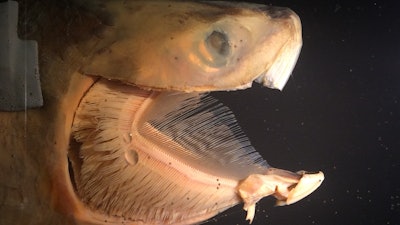
WILLIAMSBURG, Va. (AP) — For years, when biologist Laurie Sanderson peered into the mouths of filter-feeding fish, what she saw was a puzzle.
How did such fish, from the foot-long menhaden to the 42-foot whale shark, manage to filter tiny food particles so naturally, so efficiently from the water flowing into their mouths and out again?
The answer wasn't a simple dead-end sieve, like a coffee filter or colander, which ichthyologists assumed for centuries. In fact, Sanderson says, some textbooks still get that wrong.
No, what the professor at the College of William and Mary, her colleagues and students have teased out by studying the filter-feeding paddlefish and basking shark is that they have a complex mouth architecture — with a series of bone ridges or gill arches that have the marvelous ability to form vortices or eddies in the fluid flow. Those vortices serve to separate and collect tiny food bits before the filtered water is expelled.
With never a clog in sight.
"When we looked inside the mouth, what we thought we would see is spaghetti caught on a strainer," Sanderson said from her lab in Williamsburg. "But what we found in the species studied was particles dashed along at high speed toward the back of the throat toward the esophagus, and they didn't get stuck. They very rarely interacted with all those complex beautiful structures inside the fish mouth — the particles tended to go straight toward the back of the mouth."
It's a process based on cross-flow filtration that isn't unknown to industrial engineers who use similar filters to generate turbulence to help wash away accumulating particles. Such filters, however, almost always clog and must be cleaned, backwashed or scraped.
But Sanderson and her students have improved on the concept by designing a new type of clog-resistant cross-flow filter specifically to generate vortices to collect, manipulate and transport particles. They call it a "cross-step" filter, for the way fluid seems to step down as it flows over each mouth ridge.
"We are able to stop the structure from clogging immediately with all the particulates that are entering the mouth," Sanderson said. "And we're able to concentrate particles in specific regions of the mouth that a standard filter is unable to do."
The plastic model they built, based on the paddlefish mouth, is an open conical shape, with alternating rows of ribs and open slits covered by mesh.
The design is unique enough that the college has applied for a federal patent, said Jason McDevitt, director of the technology transfer office.
"We think this is a novel invention," McDevitt said. "And we believe that, ultimately, we should get a broad patent."
He envisions a range of potential commercial uses, from the dairy industry to wine- and beer-making to pharmaceuticals to water purification.
"There's a lot of different applications where you're basically separating out particles from a fluid flow," McDevitt said.
The filter can be modified as needed, Sanderson said, whether to filter out unwanted bits or collect particles and expel the fluid.
She began researching how filter-fish mouths operate about 30 years ago.
"I was intrigued because it was an unsolved problem," Sanderson said. "And it was not an easy problem to approach."
To help solve it, about 25 years ago she pioneered a way to use a tiny fiber-optic endoscope, typically used by ear, nose and throat doctors, inserted into the mouths of live aquarium fish to observe natural filtration in action.
They have yet to see vortices in live fish mouths, she said. But when her team placed preserved aquacultured paddlefish — posed with their mouths open — into a flow tank and used a bright pink dye to track the fluid flow, they did find them.
"We could see vortices where we expected to see vortices," Sanderson said. "It does suggest there's a correlation between the fish mouth and what we see happening in the model."
Their filter models are crafted using 3D printers, which offer the flexibility and freedom to make alterations as the research continues.
"We've only just begun to scratch the surface of possibilities for ways to design those models," Sanderson said. "We are inspired by the fish, so our lab group wants to continue to explore different fish species that are solving different problems. And also different methods for studying those species."
Senior Erin Roberts from Winchester said she joined Sanderson's group because she was fascinated by the professor's research into particle retention.
"I'm very interested in how morphology relates to function," said Roberts, 21. "And understanding the different physics of why different processes work in living organisms."
A biology major, Roberts said she'll be attending graduate school in Rhode Island to study the pathology of oysters — a different type of filter feeder.
And Hannah Brooks from Charlottesville, also a 21-year-old senior, said she sought out Sanderson after learning about her research.
"It was really interesting and something I'd like to be a part of," Brooks said. "Studying the specifics of how the fish works and how it filter-feeds."
Her goal after graduation is to work in an aquarium or zoo, caring for fish and educating the public.
Senior Jillian Lineburg of Lovettsville is the third member of the student team.






















